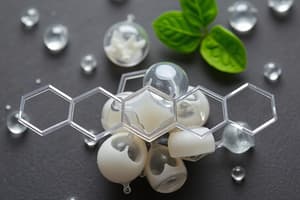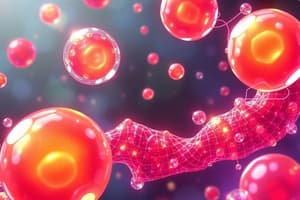Podcast
Questions and Answers
Which of the following is a classification of simple lipids?
Which of the following is a classification of simple lipids?
- Waxes (correct)
- Phospholipids
- Glycolipids
- Lipoproteins
What defines lipids in terms of solubility?
What defines lipids in terms of solubility?
- Insoluble in nonpolar organic solvents
- Insoluble in water and soluble in nonpolar organic solvents (correct)
- Soluble in both water and nonpolar organic solvents
- Soluble in water and insoluble in ether
Which function does not relate to lipids in the human body?
Which function does not relate to lipids in the human body?
- To act as heat insulators
- To produce antibodies (correct)
- To support internal organs
- To provide energy storage
How are lipoproteins classified?
How are lipoproteins classified?
What is the typically high energy yield per gram from fats?
What is the typically high energy yield per gram from fats?
What is NOT a characteristic of fatty acids?
What is NOT a characteristic of fatty acids?
Which of the following has a vital role in the conversion into vitamin D3?
Which of the following has a vital role in the conversion into vitamin D3?
Which compound provides essential fatty acids to the body?
Which compound provides essential fatty acids to the body?
What is the general structural formula of fatty acids?
What is the general structural formula of fatty acids?
Which of the following fatty acids is classified as a short chain fatty acid?
Which of the following fatty acids is classified as a short chain fatty acid?
What type of fatty acid contains at least one double bond in its hydrocarbon chain?
What type of fatty acid contains at least one double bond in its hydrocarbon chain?
Which of the following is characteristic of the carboxyl group in fatty acids?
Which of the following is characteristic of the carboxyl group in fatty acids?
Palmitoleic acid is classified as what type of fatty acid based on its structure?
Palmitoleic acid is classified as what type of fatty acid based on its structure?
Which carbon in a fatty acid is referred to as the terminal methyl carbon?
Which carbon in a fatty acid is referred to as the terminal methyl carbon?
Arachidonic acid can be acquired through diet or converted from which fatty acid?
Arachidonic acid can be acquired through diet or converted from which fatty acid?
Which of the following correctly describes saturated fatty acids?
Which of the following correctly describes saturated fatty acids?
Which type of fatty acid has both hydrogen atoms located on the same side?
Which type of fatty acid has both hydrogen atoms located on the same side?
What role do COX-derived eicosanoids such as prostaglandins and thromboxanes play in the body?
What role do COX-derived eicosanoids such as prostaglandins and thromboxanes play in the body?
Which of the following is an essential fatty acid that must be obtained from diet?
Which of the following is an essential fatty acid that must be obtained from diet?
Which lipid category contains substances such as leukotrienes and lipoxins?
Which lipid category contains substances such as leukotrienes and lipoxins?
What characteristic distinguishes trans fatty acids from cis fatty acids?
What characteristic distinguishes trans fatty acids from cis fatty acids?
What differentiates non-essential fatty acids from essential fatty acids?
What differentiates non-essential fatty acids from essential fatty acids?
Which enzyme system is responsible for forming non-essential fatty acids in the liver?
Which enzyme system is responsible for forming non-essential fatty acids in the liver?
What is the primary negative health effect associated with trans fats?
What is the primary negative health effect associated with trans fats?
Flashcards are hidden until you start studying
Study Notes
Lipids: Definition and Importance
- Lipids are a diverse group of organic compounds with a defining characteristic: they are insoluble in water.
- This insolubility is due to the predominance of hydrocarbon chains in their structure, making them hydrophobic (water-hating).
- Lipids are crucial for our health, contributing to:
- Dietary essential fatty acids: Providing the body with vital fatty acids we can't produce ourselves.
- Fat-soluble vitamin source: Carrying important vitamins like A, D, E, and K.
- Significant source of energy: One gram of fat provides roughly 9 kilocalories.
Lipid Classification
- Simple Lipids: Esters of fatty acids with various alcohols, forming fats or waxes.
- Complex Lipids: Esters of fatty acids with alcohols, but with additional groups:
- Phospholipids: Lipid + phosphatidic acid
- Glycolipids: Lipid + carbohydrates
- Lipoproteins: Lipid + proteins
- Precursor and Derived Lipids: Products derived from the hydrolysis of simple and complex lipids:
- Steroids: Important hormones and structural components.
- Carotenoids: Pigments with antioxidant properties.
- Ketone bodies: Fuel sources during fasting or prolonged exercise.
- Fat-soluble vitamins: A, D, E, and K.
Fatty Acids: Structure and Classification
- Definition: Aliphatic, linear monocarboxylic acids.
- Structure: General formula: R-COOH, where R represents the aliphatic hydrocarbon chain responsible for its nonpolar nature, and the carboxyl group (-COOH) is polar and hydrophilic.
- Amphipathic Molecule: Possesses both a polar (hydrophilic) carboxyl group and a nonpolar (hydrophobic) hydrocarbon tail.
- Carbon Atom Numbering:
- The carbon adjacent to the carboxyl carbon is the α-carbon, followed by β, γ, and so on.
- The terminal methyl carbon (CH3) is called the ω-carbon.
Fatty Acid Classification
- Chain Length:
- Short-chain fatty acids (SCFA): 2-10 carbon atoms (e.g., acetic acid, propionic acid, butyric acid).
- Long-chain fatty acids (LCFA): More than 10 carbon atoms (e.g., palmitic acid, stearic acid).
- Saturation Level (Presence of Double Bonds):
- Saturated fatty acids: No double bonds in the hydrocarbon chain.
- Unsaturated fatty acids: At least one double bond.
Unsaturated Fatty Acid Classification
- Number of Double Bonds:
- Monounsaturated fatty acids: One double bond (e.g., palmitoleic acid, oleic acid).
- Polyunsaturated fatty acids (PUFA): More than one double bond (e.g., linoleic acid, α-linolenic acid, arachidonic acid).
- Omega/Delta Nomenclature: Used to classify fatty acids by the position of their last double bond from the methyl end (ω-carbon).
- Omega (ω) classification: Counts the position of the last double bond from the methyl end.
- Delta (Δ) classification: Indicates the carbon atoms involved in the double bond using numbers (e.g., Δ9 indicates a double bond between carbon atoms 9 and 10).
Essential Fatty Acids
- Definition: Fatty acids that cannot be synthesized by the human body and must be obtained from the diet.
- Importance: The body lacks enzymes to introduce double bonds beyond the 9th carbon atom, making these fatty acids essential.
Eicosanoids
- Definition: Compounds derived from 20-carbon (eicosa-) polyunsaturated fatty acids.
- Types: Prostanoids, Leukotrienes, and Lipoxins
- Prostanoids: Include prostaglandins (PGs), prostacyclins (PGIs), and thromboxanes (TXs). Important in regulating cardiovascular function and tumor progression.
- Leukotrienes (LTs): Important mediators of inflammation and asthma.
Cis and Trans Fats
- Cis fatty acid: Two hydrogen atoms are on the same side of the double bond.
- Trans fatty acid: Hydrogen atoms are on opposite sides of the double bond.
- Health Implications: Cis fats are generally healthier than trans fats. Cis fats are associated with good cholesterol, while trans fats can clog arteries and increase bad cholesterol.
Non-Essential Fatty Acids
- Definition: Fatty acids that can be synthesized by the body.
- Synthesis: Made by the Δ9 desaturase enzyme system in the liver.
- Examples: Saturated and monounsaturated fatty acids.
Nutritional Value
- Essential Fatty Acids: Cannot be synthesized in the body, must be obtained from the diet.
- Non-Essential Fatty Acids: Can be synthesized by the body.
- Examples:
- Essential: Linoleic acid, alpha-linolenic acid, arachidonic acid.
- Non-Essential: Saturated and monounsaturated fatty acids.
Summary
This lecture explores the world of lipids, starting with their fundamental characteristics and functions in the body. You will gain a deeper understanding of fatty acid structure, their classification based on chain length, saturation, and omega nomenclature. It highlights essential fatty acids and their vital role in our health along with the role and structure of eicosanoids and the differences between cis and trans fats.
Studying That Suits You
Use AI to generate personalized quizzes and flashcards to suit your learning preferences.




